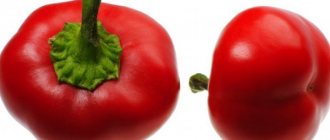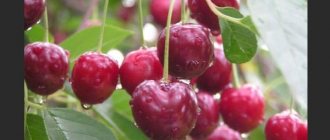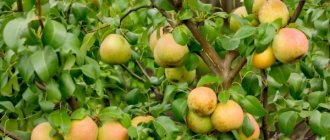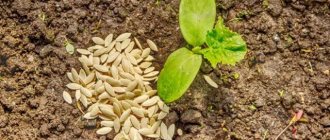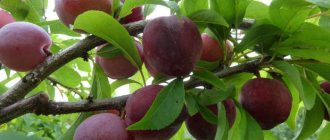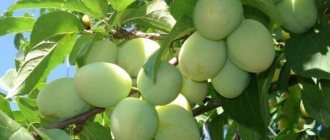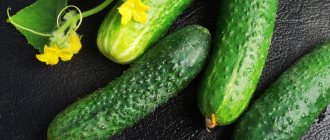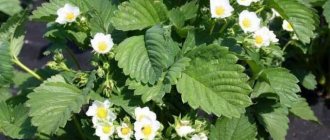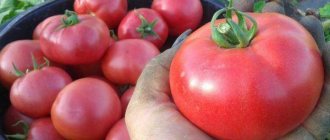Ruby Jubilee is a hybrid form of table grape, bred by one of the founders of domestic folk selection, Viktor Krainov from Novocherkassk. Since 1953, Viktor Nikolaevich has been growing sunberries on his plot on the banks of the Tuzla River, and after decades of practical viticulture, he decided to also engage in the selection of new hybrids. The first impetus for research activities and enormous theoretical support along this path were provided to Krainov by the famous scientist from the All-Russian Research Institute of Viticulture and Winemaking, Ivan Kostrikin. The result of a successful symbiosis of carriers of a gigantic store of theoretical knowledge and practical experience was the appearance of many magnificent varieties, the best of which were even included in the State Register of Breeding Achievements of the Russian Federation. But those creations of Krainov, which were not awarded such an honor, have, for the most part, become very popular among grape lovers and currently grow on vast areas of farm and summer cottage plots.
One of these hybrids, widespread in amateur plantings, is Ruby Jubilee - a large-fruited grape with berries that are stunning in color, taste and aroma. It received its name in connection with the 40th anniversary of Viktor Nikolaevich’s married life with his other half. Such a round date is popularly called a ruby wedding. So the author presented his wonderful new product as a gift to his wife.
The parent pair of this grape variety was the breeder's favorites - the varieties Talisman and Kishmish radiant. The first is distinguished by the gigantic size of bunches and berries, relative resistance to disease and frost, as well as a functionally female type of flowering, making it very convenient for enthusiastic researchers. The second representative of the pair, Kishmish radiata, was responsible for the magnificent aesthetic and taste qualities of the future offspring. This combination of crossing turned out to be perhaps Krainov’s most productive - at different periods of time, he identified several promising hybrids through it, including his famous “troika” - Preobrazhenie, Jubilee of Novocherkassk and Victor. And here it is worth noting that Ruby Jubilee is absolutely not behind its illustrious brothers, and in some respects, in particular in its wonderful aroma, it even surpasses them.
Grape variety Ruby Jubilee
Ruby Jubilee is a hybrid form of table grape, bred by one of the founders of domestic folk selection, Viktor Krainov from Novocherkassk. Since 1953, Viktor Nikolaevich has been growing sunberries on his plot on the banks of the Tuzla River, and after decades of practical viticulture, he decided to also engage in the selection of new hybrids. The first impetus for research activities and enormous theoretical support along this path were provided to Krainov by the famous scientist from the All-Russian Research Institute of Viticulture and Winemaking, Ivan Kostrikin. The result of a successful symbiosis of carriers of a gigantic store of theoretical knowledge and practical experience was the appearance of many magnificent varieties, the best of which were even included in the State Register of Breeding Achievements of the Russian Federation. But those creations of Krainov, which were not awarded such an honor, have, for the most part, become very popular among grape lovers and currently grow on vast areas of farm and summer cottage plots.
One of these hybrids, widespread in amateur plantings, is Ruby Jubilee - a large-fruited grape with berries that are stunning in color, taste and aroma. It received its name in connection with the 40th anniversary of Viktor Nikolaevich’s married life with his other half. Such a round date is popularly called a ruby wedding. So the author presented his wonderful new product as a gift to his wife.
The parent pair of this grape variety was the breeder's favorites - the varieties Talisman and Kishmish radiant. The first is distinguished by the gigantic size of bunches and berries, relative resistance to disease and frost, as well as a functionally female type of flowering, making it very convenient for enthusiastic researchers. The second representative of the pair, Kishmish radiata, was responsible for the magnificent aesthetic and taste qualities of the future offspring. This combination of crossing turned out to be perhaps Krainov’s most productive - at different periods of time, he identified several promising hybrids through it, including his famous “troika” - Preobrazhenie, Jubilee of Novocherkassk and Victor. And here it is worth noting that Ruby Jubilee is absolutely not behind its illustrious brothers, and in some respects, in particular in its wonderful aroma, it even surpasses them.
Ruby Jubilee
“Ruby Jubilee” is a fairly unpretentious hybrid variety of table grapes, which is distinguished by large clusters of sweet large berries.
Features of the grape variety “Ruby Jubilee”
This variety is suitable for both cultivation on a professional scale and for cultivation in personal plots.
It is distinguished not only by its tasty fruits, but also by its bright green leaves, which are also used in cooking, for example, for making dolma. These grapes are excellent for making various wines. And its fleshy red berries attract not only their luxurious appearance, but also their unforgettable, nutmeg with a strawberry tint, taste. The characteristics of "Ruby Jubilee" make it very attractive for cultivation:
- This honeycomb can be classified as mid-early. This is confirmed by its ripening time, which ranges from 105 to 125 days;
- On bushes of medium height, large cylindrical clusters ripen, the weight of which can reach 800 grams;
- The berries are large (average weight about 12.5-17 grams), oval and with thin skin. The sugar content of the fruit is 15-16%, and the acidity is in the range of 6-7 g/l.
The advantages of the “Ruby Anniversary” variety include the fact that the crop is perfectly preserved on the bush and tolerates transportation well, during which the berries retain their presentation and do not crack.
The vine is characterized by strong growth and shows high resistance to various diseases, but this does not eliminate the need for prevention. The seedlings take root well, and the bisexual flowers are well pollinated. Despite the abundance of advantages, there are also some disadvantages that can be overcome. “Ruby Jubilee” can withstand temperatures down to -21C°, and due to the fact that the core cannot withstand severe frosts, the vine must be covered for the winter. Under unfavorable weather conditions, severe shedding of flowers occurs. This variety is very popular with bees and birds, which can cause significant damage to the crop. To avoid this, it is imperative to protect the bunches.
How to plant and care for "Ruby Jubilee"
If you decide to grow this variety on your site, you first need to decide on a suitable location. For this, the southern or southwestern side of the site, protected from the winds, where there is no close groundwater, is best suited. In the fall, you need to prepare holes (about 60 cm deep and wide, at a distance of 2 meters) and add fertilizer (superphosphate) to them. And in the spring, prepare the seedlings by letting them stand for about a day in a solution that stimulates growth, and proceed directly to planting. Cover the plant with soil mixed with humus, leaving about 10 cm to the surface for a layer of mulch. It is necessary to water abundantly and shade the seedlings for 14 days.
Watering should be done regularly every two weeks. If there is not enough water, the skins on the grapes will become rough and crack. A break should be taken for the period when the plant blooms to prevent flowers from falling off and poor pollination. And then, when no more than three weeks remain until harvest, the application of moisture should be stopped.
In order to grow a good harvest of Ruby Jubilee grapes, you need to regularly apply fertilizer:
- At the beginning of spring: chicken manure with nitrophoska or ash with urea;
- 20 days before flowering: fertilizing with boron and zinc;
- After flowering: fertilizing with boron, spraying the leaves with manganese sulfate;
- In summer: fertilize with fertilizer containing nitrogen, phosphorus and potassium. The same fertilizers should be applied when the fruits begin to form;
- If the plant does not show sufficient growth, then it is necessary to feed it with a composition containing a complex of minerals.
In addition to fertilizing, it is important to practice proper pruning of the vine.
With the onset of spring, until the temperature exceeds 4-6C°, damaged branches need to be trimmed. In the summer, stepsons need to be removed. And before covering the vine for the winter in the fall, the vine is pruned, leaving no more than eight eyes on the shoot. Disease resistant, “Ruby Jubilee” needs to be sprayed with Bordeaux mixture (1%). To protect plants from damage that can be caused by grape budworms, the vine must be periodically treated with insecticides.
Bred by breeder V.N. Krasnov, the “Ruby Anniversary” variety will certainly decorate your site. Unpretentious in care, it will delight you with an abundant harvest of large bunches of delicious grapes.
Agrobiological characteristics of the variety
Plants have above average growth vigor. The crown of the young shoot is green with light cobwebby pubescence. The grape leaf is quite large in size, dark green, round, five-lobed, strongly dissected, with a flat and smooth surface. The upper lateral notches are deep, usually open, lyre-shaped, with a rounded bottom, sometimes with a tooth at the bottom. The lower notches are of smaller depth, varied in shape: from vaulted with a bottom similar to the upper notches, to V-shaped, and even barely outlined. The petiole recess is open, wide-vaulted with a flat-pointed bottom. Petiole green, medium length. The denticles along the edge of the leaf are well-developed, sawtooth, with smooth edges and sharp peaks, varying in size. The flowers of the variety are bisexual, confidently pollinated by their own pollen, but tend to fall off in rainy weather during flowering. The Ruby Jubilee vines are maturing well.
The clusters are large and very large, cylindrical, moderately dense, weighing from 600-800 grams (average), up to 2 kg (maximum). In case of significant shedding of buds during flowering, the brushes may be incomplete and very loose. The legs of the combs are long, well developed and strong, green in color with a slight pink tint. The berry is large, oval or oval-cylindrical, with an average length of 32 mm, a diameter of 24 mm, and a weight of 8-12 grams. The grapes are distinguished by a fairly even caliber on the bunch and do not show signs of peas. The grape pulp is medium density, juicy and fleshy, with a pleasant harmonious taste and a well-defined muscat aroma, which significantly increases its tasting characteristics. The skin is quite thin, easy to chew, painted in an elegant pink color, the intensity of which, like many Kraynovsky varieties, depends on the air temperature during the ripening period and the sun exposure of the bunches. The surface of the berry is covered with a smoky waxy coating. Freshly squeezed juice, uncolored. Its sugar content is 16−17 grams/100 cubic meters. cm, titratable acidity - 5−6 grams/liter. There are 2-3 seeds in the berry, but due to their average size and significant volume of pulp, they are not too noticeable during tasting. The gastronomic characteristics of the Ruby Jubilee are consistently excellent; many recognize it as one of the most delicious modern hybrid forms.
It is most advisable to use grapes for eating fresh, but in case of a rich harvest, its surplus can be successfully used for processing into aromatic juices, compotes and jam. For winegrowers cultivating the crop for commercial purposes, Ruby Jubilee will undoubtedly be of interest due to the attractiveness and high marketability of its fruits. It ripens somewhat later than the famous varieties of Kraynov’s “troika”, and can take its rightful place in the “conveyor” of large-fruited pink-colored varieties, thereby extending the period of their continuous sale. The transportability of the bunches is quite sufficient for transportation over long distances, and they are well adapted for storage, especially in optimal conditions of refrigeration chambers.
The grape harvest reaches mass ripeness in the early-mid period - in the south in the third ten days of August. The growing season, counting from the moment of bud break, lasts 115-125 days. The variety's heat requirement, expressed as the sum of active temperatures, is 2500−2600°C. For comparison, a similar level of SAT is typical for the latitude of Kaliningrad, Kaluga and Ryazan, which makes it quite possible to grow and stable ripening of Ruby Jubilee in these areas, provided that the plants are protected from winter cold. The frost resistance of the hybrid does not exceed -23°C, which allows it to be cultivated without shelter only in the southern regions of the country.
Related article: Planting vineyards - A manual for table grape producers - grapes
The potential yield is quite high - up to 15-20 kilograms from a well-developed adult bush, but the actual yield depends on a set of factors related to proper care and favorable weather conditions, especially during the flowering period of grapes. The variety is highly prone to overloading, which must be kept in mind by every winegrower cultivating it. Already ripe bunches can continue to hang on the bushes for quite a long time without reducing their presentation and taste. However, due to the presence of conflicting information about the resistance of berries to cracking, it would be a good idea to protect the crop by timely harvesting in dry years, when unexpected precipitation can lead to a sharp change in soil moisture and subsequent damage to the fruit. The berries also need protection from wasps, of which the most reliable option is to place the bunches in individual mesh bags.
Agrotechnical features
It can be stated with confidence that cultivating Ruby Jubilee is not an overly difficult task and can be done by most winegrowers who have a basic understanding of table grape agricultural technology. At the same time, in order to obtain the highest quality harvest and increase its volume without harming productive plants, it is necessary to take into account certain specifics that the variety requires for self-care.
The bushes grow equally well both on their own roots and in a grafted culture. The hybrid has good rooting ability of cuttings and fusion with various rootstocks; the choice of propagation method is determined only by the presence of a dangerous pest in the soil - root phylloxera. In areas infected with it, rooted plants may die within a few years after planting, which is why in these places it is necessary to plant seedlings grafted onto phylloxera-resistant rootstocks. The feeding area of a grape bush when planting should be 4-6 square meters. meters.
The growth and development of Ruby Jubilee is quite active, however, on insufficiently fertile soils, in order to quickly enter full fruiting, it requires additional feeding, which ensures significant annual wood growth. Formation depends primarily on climatic conditions and the need to cover the vines for the winter. In traditional grape growing regions, where there is no significant risk of the above-ground parts freezing in winter, the bushes are formed on a high trunk with powerful sleeves and cordons. In such conditions, they will show their strongest qualities and produce numerous, large-sized, sweet and very fragrant clusters. If there are concerns about the sufficient frost resistance of the variety, you can simultaneously create an additional lightweight lower tier, which will provide shelter for the winter and serve as a reserve. In those places where winter temperatures regularly drop below - 23 °C, it is necessary to fully insulate the plants, and therefore they are formed without a trunk, usually according to the pattern of an oblique cordon or a multi-armed fan. The heat-insulating layer can be either the soil itself or organic materials - sawdust, straw, spruce branches or reed mats. The construction of film tunnel shelters like mini-greenhouses also shows good results.
Due to the clearly expressed tendency of the Ruby Jubilee to overload, high-quality rationing of grape bushes by harvest is required. The number of eyes left during spring pruning depends on the chosen formation and the overall vital energy of the plant, ranging from 30 to 45. It is recommended to shorten the fruit shoots by 8-10 buds. After breaking off weak and fruitless shoots, the number of fruitful shoots should be 20-24, on which, after the appearance of the ovary, it is necessary to leave one of the strongest bunches. Thinning the clusters at the flowering stage is not recommended for this variety, so as not to aggravate the existing predisposition to shedding of inflorescences. Moreover, to reduce the harmfulness of this negative distinctive feature, it is recommended to pinch fruit-bearing shoots before flowering, as well as to use specialized preparations and chemical compositions that reduce the likelihood of grape inflorescences falling off.
The fight against diseases in Ruby Jubilee must be carried out quite seriously, since the variety has average resistance to them. Preventive treatments against mildew and oidium must be carried out before and after flowering, and then repeated at the first symptoms of plant damage by pathogens. Wasps, as already mentioned, must also be fought and the ripening bunches must be protected from these insects. Cracking and subsequent rotting of the berries can be prevented by monitoring the water regime of the soil, watering the bushes on time, and avoiding excessive drying of the soil underneath them.
With regard to the color intensity of mature brushes, Ruby Jubilee exhibits the same properties that are characteristic of other forms of selection by Viktor Krainov, obtained by crossing Talisman and Kishmish radiata. Thus, the most elegant color of berries is formed on shaded bunches, especially in a moderate, not too hot climate. In the sultry summer in the south, with active insolation, the harvest is literally baked, never having time to acquire its rich pink color, as happens without problems in non-traditional northern viticulture regions. In this regard, fans of this variety are advised not to overuse the lightening of grape bunches during their ripening period, or even abandon this procedure altogether, and even work on creating additional shading of the fruit zone of the bush, thus achieving not only large, tasty and aromatic harvest, but also incredibly attractive in appearance.
What type does it belong to?
Ruby Jubilee is a hybrid table subspecies. Table hybrids also include Zarya Nesvetaya, Russian Korinka and Ataman Pavlyuk.
Harvest ripening period is early-medium. The berries ripen by the end of August, but it is better to wait until mid-September and then pick them.
The point here is not only in sugar accumulation - it turns out that Ruby Jubilee turns into a “ripe” color much earlier than the berries acquire all those qualities that are inherent in ripe grapes.
It is used in bouquets of red table and dessert wines, but is also good fresh, thanks to its sweetness and rich, revealing taste with noticeable muscat, rose and strawberry notes.
Velika, Krasa Balki and Romeo also boast excellent taste.
It is in great demand among buyers not only because of its beauty and sweetness, but also because of the fruit’s extraordinary resistance to storage and transportation.
Gardeners often confuse Ruby Jubilee with Anyuta early, believing that they are the same variety. But this is not so, even in appearance - the clusters of Ruby Jubilee are richly red, and Anyuta early is golden-pink. Yes, and it ripens earlier.
Pharaoh, Sangiovese, Violet early and Rochefort also have an early ripening period.
Detailed description
The bushes of this plant are of medium height. The bunches are cylindrical in shape, the average weight of one is 600 grams. The berries are very large, oval, have a scarlet-ruby, very beautiful color. The skin is thin and tastes of honey, nutmeg and lemon. The plant has flowers of both sexes. The variety is mid-early. The berries can be eaten not only fresh, but also made into delicious wine.
We suggest you familiarize yourself with Urea for flowers application
Such a berry practically does not form cracks. The plant is quite capable of withstanding the thermometer dropping down to -22 degrees. For this reason, in southern latitudes grapes are not covered, but in the middle zone it is worth taking care of winter shelter. The disadvantage of this variety is the large shedding of flowers from the bush.
Grapes Ruby Jubilee: variety description
The bushes are medium-sized. The bunch is medium-sized, cylindrical, moderately dense, up to 1 kg. Rarely peas. The berry is oval, very large, weighing on average 17 g, deep red in color with a ruby tint and on a strong stalk. This is the only way, no golden ones with a pinkish tint - this is Anyuta early, with which Ruby is quite often confused.
Such varieties as Lydia, Pinot Noir and Golubok are also distinguished by their medium height.
The skin of the berry is of medium thickness, almost unnoticeable when eating, the pulp is juicy, crunchy, with a nutmeg flavor and pink notes. The leaf is dark green, medium size, rounded, medium dissected. The flower is hermaphrodite. The ripened shoot is brown with red nodes.
Photo of Ruby Jubilee grapes:
Description of the Rubina Jubilee grape variety and its characteristics
Not only professionals, but also amateurs can breed new plant varieties. Grapes are no exception. Scrupulous and long work has given birth to many interesting varieties of this plant. Scientists often conduct experiments when breeding varieties, and the Ruby Jubilee variety became a successful result of such activities. Not only the berries, but also the leaves of this variety are used in cooking. The fruits are not only eaten, but also used in the treatment of colds, tuberculosis, blood pathologies, and also for cosmetic purposes.
History of selection
The ruby jubilee was bred by amateur breeder V.N. Krainov as a gift to his wife for the ruby wedding - the fortieth anniversary of their marriage.
This breeder also owns Blagovest, Victor and Angelika.
Farmers immediately appreciated this variety. Currently, Ruby Jubilee is grown in the Kherson region, Zaporozhye, Crimea, Rostov region, and Krasnodar region. It is not found in the central regions due to the fact that it does not tolerate severe cold, which is characteristic of most of Russia.
Characteristics
The variety is strong and unbending, as it should be a symbol of true love. He is not afraid of powdery mildew - oidium and mildew, or various types of rot, or other bacterial diseases of grapes.
True, it is not very resistant to wasps. The yield of the variety is high, it needs to be rationed with eyes and shoots. Trim to six to eight eyes, leaving the norm at 35 per bush.
In unfavorable years, the flowers fall off greatly. The ripening of the vine is almost the entire length of the growth. The percentage of sugar content is up to 20 Brix.
Vodograi, Tien Shan and Rozmus also prefer to spend the winter in shelter.
Diseases and pests
This “symbol of love” definitely needs protection from wasps. Therefore, the clusters must be packed in special mesh bags. They will provide access to sun and fresh air, but will not allow striped invaders to get to the berries.
It is also good to use sticky baits, preferably odorless. All wasp families and “family estates” found on the site must be destroyed.
Please note that wasps simply love to build nests in hollow pipes that support bushes. Therefore, all these holes will have to be sealed.
The birds will also be stopped by a net - just not a fishing net, but a hard and fine-mesh one. The bird will not get confused in it and will simply fly away.
These weevils literally eat everything they see, and what they don’t eat, they bite it off, and no one will need your harvest: it will either dry out or rot.
Therefore, we spray the bushes with chemicals - these include Tsimbush, Tokution, Sevin, Tsidial, Sumicidin, Ekamet, Fozalon. Light traps against long-nosed moths are ineffective, and even then, males usually “peck” at them.
Do not forget also about preventive measures against rubella, chlorosis, anthracnose and bacteriosis. They will never hurt and will avoid many troubles.
Everything that is based on love lasts a long time. Ruby Jubilee will also live for a long time, including on your site.
Just don’t be lazy, take care of it, cover it for the winter months, spray it against pests, put up nets against wasps and birds - and then you and everyone who comes to your house will enjoy both the beauty of the grapes and the wonderful berries and homemade wine.
Pests and diseases
This variety is highly resistant to major diseases:
Despite such strength, it is better not to cancel preventive measures. For all fungal pathologies, the plant should definitely be treated with a 1% solution of Bordeaux mixture. These grapes are often attacked by wasps. For this reason, the bunches are often wrapped in a mesh bag. Sticky traps are often used, but it is better to use ones that are odorless. Birds are also not averse to eating grapes; a fine mesh net is used to keep them away.
Characteristics and description of the variety
The bright Jubilee berries attract the attention of any passerby. They ripen by the end of August, since the fruiting period takes 120-130 days. The shape of the fruit is round, weighty, the weight of one berry can easily reach 20 g. The color of the skin is combined: red-pink with yellow tints. The skin is practically unnoticeable because it is thin. The taste of the berry pulp is sweet, with an aftertaste of honey. The amount of sugar in the composition is 15-17 g, the acid content is 6-7 g/l. Due to their thin but durable skin, the berries withstand transportation well, which is why they are grown for sale. Ruby Jubilee is used for fresh consumption, but the berries are suitable for the production of homemade wines and liqueurs. Housewives use grape leaves to prepare dolma - they are durable and beautiful.
Related article: Bacterial cancer in questions and answers
The bush is medium in height, its length rarely exceeds 5 m. From the moment of planting, the vine is tied to a support or trellis. Pruning is necessary 1-2 times a year. The best yield is observed when there are no more than 30 eyes on the bush. Cut off 6-8 eyes at a time. The vines contain clusters of grapes weighing about 700-800 g. Ripening is good, the berries ripen at the same time. Ripened shoots become brown with dark green foliage. Flowering occurs quickly in the summer. The flowers are hermaphrodites, so pollinators are not needed for fruiting.
The Ruby Jubilee spread to the Crimean Peninsula, Rostov Region and Krasnodar Territory. It is less commonly grown in the Moscow region and Leningrad region due to its low frost resistance. The shoots are able to withstand frosts down to -20 degrees, but overwinter only in shelter. Rainy, cloudy weather affects the quality of the berries and the quantity of the harvest, so Ruby Jubilee is grown mainly in the south of the country.
The variety is considered resistant to many grape diseases. Ruby Jubilee is slightly affected by mildew or oidium, and is not afraid of rot and other bacteria. Preventive treatment is needed, it is carried out 2 times a year: in spring and autumn. For treatment, use copper sulfate, Bordeaux mixture or any fungicidal agents.
Ruby Jubilee has a number of positive qualities:
- large beautiful berries of unusual color;
- stable harvest;
- strong immune qualities;
- powerful shoots and abundant fruiting;
- unpretentiousness to planting soil.
Among the disadvantages of cultivation, it is noted that the variety attracts the attention of wasps. For protection, you need to provide a special shelter for the grapes or purchase insect traps. Birds sometimes attack the berries, but they can be easily repelled with fine mesh.
How to plant
It is better to locate the area for grapes on the south side or in the southwestern part. It is necessary to think about protection from the wind; there may be, for example, a fence on the north side. Grapes are not grown near trees; the shady zone is destructive for them. The groundwater level must be at least 1.5 m. Soil for the crop is laid in autumn or spring. Planting holes are dug in the ground 70-80 cm deep and with approximately the same diameter. First pour a bucket of any drainage into the hole, and then ½ kg of superphosphate and a bucket of humus.
Planting of seedlings begins in the spring, in early or mid-April. During the day, the seedling is soaked in a solution that stimulates the development and growth of the rhizome. The growth stimulator should consist of succinic acid, sodium humate, and root. Such a nutrient mixture will give strength to the roots, and they will quickly adapt to the new place. The roots of the seedling are immersed in a hole with fertile soil and dug in, leaving the root collar outside. For the first 2 weeks of cultivation, the seedlings are slightly shaded.
Landing
Selecting a location
Ruby Jubilee grapes are planted on the south side of the plot or southwest side. It must be protected from north winds. Bushes are planted from north to south. Some bushes can be planted on the south side near the house. Grapes grow very poorly next to poplars, hazel trees and walnuts. You cannot plant grapes in an area with close groundwater.
Soil preparation
In the fall, dig up the soil and dig holes 60-70 cm deep and 50-60 cm in diameter. Pour 0.5 kg of superphosphate into the hole. Stir and add 25 cm of soil mixed with humus or mullein.
Cherry variety Leningradskaya black: biological description, crop care, features and disadvantages
Description of landing
In the spring, place the seedling for 20 hours in solutions with growth stimulants: succinic acid, sodium humate, root. Add soil into the hole until a mound of 45 cm is formed. Place the seedling on the mound, then add soil with humus or rotted manure. The hole is not filled to the top with soil, but 10 cm is left to the top.
The soil is compacted and watered with warm, settled water. The grapes are watered regularly after planting. The seedlings are shaded for 2 weeks.
Landing dates
In the south, grapes are planted in autumn and spring. In the north they are planted only in spring. The space between bushes should be 2 m, between rows 2.5 m.
How to care
In the first year of growing the crop, the seedling is not often watered (once a month), the soil is loosened and treated with fungicidal preparations against diseases and pests. The first watering is carried out immediately after planting the seedling in a permanent place. After watering, the soil is loosened; if weeds appear, they are pulled out. When the first leaves begin to actively grow, the trunk is freed from the earthen layer. In June, a hole is made around the plant so that the surface roots get used to the surrounding temperature. If the roots are not hardened, the plant will form slowly and sluggishly. The hole is buried only in mid-August, when it gets noticeably colder outside.
You can form a vine from the first year of growing the crop. The strongest and most powerful shoot is left, and the rest is cut off. Subsequent pruning is carried out in the fall, after harvest and in the spring. First of all, old, dried branches or weak shoots are removed. For pruning you need pruning shears or a sharp knife; breaking off branches is undesirable, as you can damage the vine.
Features of cultivation and care
Without care, the grapevine will grow worse and produce less yield. Timely application of fertilizers will increase the plants' resistance to diseases.
Vine pruning
In the summer, stepchildren are mostly pruned. The main pruning is carried out in the fall. The procedure is aimed at increasing productivity. Pruning is carried out 2 weeks after harvest.
See also
Description and characteristics of the Arch grapes, history of the variety and cultivation rulesRead
Stages of pruning the vine:
- The vine is pruned until living wood grows (when cut, the color of the vine should be light green);
- Leave 2-3 cm of vine on the living bud.
In summer, 2 strong shoots are left and the rest is cut off. Several buds are left on each branch. The branches are spread to the sides. After a year, some of the branches are cut off. 2-3 branches with several shoots are left on each side. In subsequent years, the branches are pruned so that the plant is not thickened.
Irrigation
Grape bushes grow well even without watering due to their powerful root system. In the spring, the bushes are watered at the onset of the growing season, when the leaves and buds bloom.
In summer, the plant is watered while grapes are being poured. No watering is needed before or during flowering. Due to humidity, the inflorescences fall off. The grapes are watered for the last time before the onset of cold weather to prepare the plant for winter.
Fertilizer
The first feeding is carried out after the formation of ovaries. Nitrogen is added to the soil. The second time - a week before flowering. Organic matter, phosphorus or potassium are added to the soil. Foliar feeding is carried out 2-3 days before the inflorescences bloom.
The second time the vine is sprayed with fertilizers 5 days after bud break. And the last time - 5 days after flowering.
Before the onset of cold weather, nitrogen, wood ash and mineral fertilizers are added to the soil. This will prepare the rhizome for winter.
How to cover for the winter
Ruby Jubilee almost always needs shelter. The exception is the southern regions with warm winters. They begin to prepare for winter in October. The vine is cut off from its leaves and removed from its support. A trench is dug near the place where the grapes are grown. Peat is placed in the trench, and shoots are lowered from above. The shoots are buried in soil. A layer of cellophane or roofing felt is placed on the bed. When snow covers the ground, it is raked from above onto the shelter. In the spring, the snowdrift is removed, otherwise the melted snow will wash away the soil.
Planting seedlings
Planting young seedlings in a permanent place is an important stage, during which the foundation is laid not only for the harvest, but also for the plant’s immunity.
Preparing the landing site
For planting, choose open sunny areas. Since grapes belong to the southern plants, where there is a lot of sunlight and heat, the bushes grow very poorly in the shade and practically do not produce a harvest.
In addition, it is important that the area is protected from the wind. The best option for planting would be the walls of the house on the south side. Before planting, you should step back 1 m from the wall. Grapes prefer to grow on loamy or sandy loam soils.
Setting the stage
Stages of preparing a site for planting grape seedlings:
- Dig a hole to a depth of 80 cm.
- Fill the bottom with fine drainage.
- Then mix the top layer of soil with manure and mineral fertilizers for growth and fill the hole with the resulting soil mixture.
- Leave the place for 1-2 weeks.
If necessary, deoxidize the soil with dolomite flour. It is not recommended to plant grape bushes on acidic soils. After 7-14 days, they begin to plant the seedling.
When can I plant
It is recommended to plant the Ruby Jubilee hybrid in early October and before the onset of the first autumn frosts. Over the winter, the seedlings will have time to take root, and in the spring they will begin to grow actively. You can also plant grape bushes in the spring, after the snow has melted and the weather has warmed up.
Description of actions: what's behind what
Stages of planting a seedling in open ground:
- Dig a hole with parameters 80 x 80 x 80.
- Drive a metal pipe into the bottom of the hole and another one nearby.
- Drainage is poured to the bottom, and then 150 g of potash fertilizers.
- Place the seedling in the hole and cover it with soil.
- Lightly compact near the trunk.
At the end of planting, water generously with warm water. Grape seedlings are not recommended to be planted next to other plants. It is undesirable to bury the seedling, this will negatively affect the growth of the plant. If you plant only female varieties, then over time the crop will become smaller. Any pollinating variety must be planted nearby.
Nepenthes - home care, photo and description of a carnivorous plant
